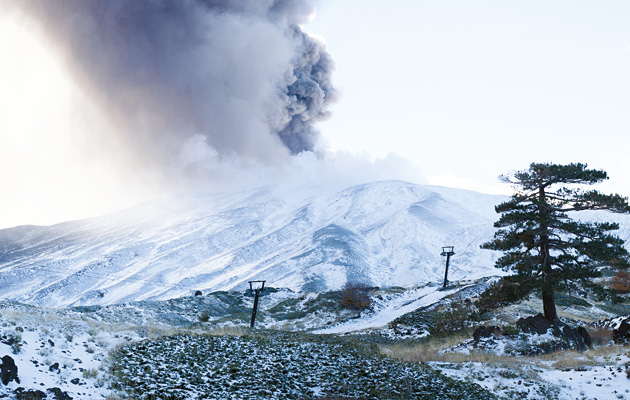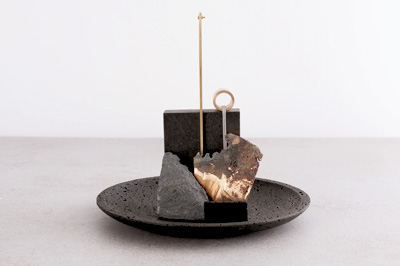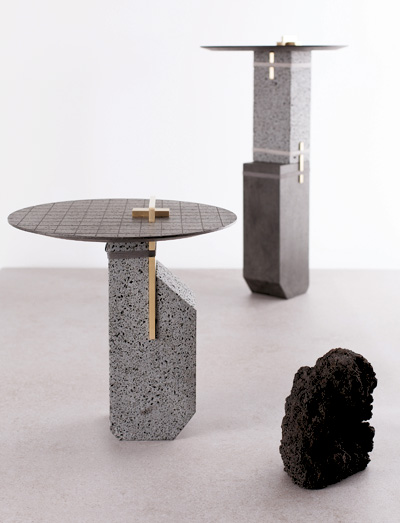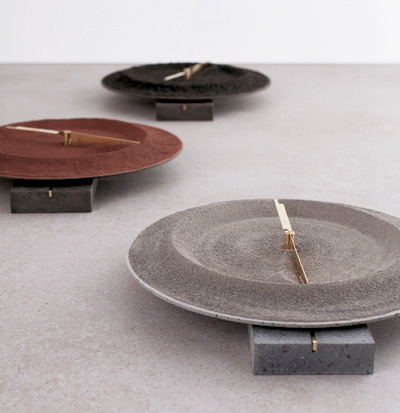
Mount Etna photographed during the duo’s field investigations earlier this year
|
Formafantasma has spent three years studying the geology of Mount Etna, exploring the effects of time on volcanic rock, and even forging it into new materials. Now its labours have come to fruition in a collection of lava-based objects This article was first published in Icon’s July 2014 issue: Underground, under the headline “Active ingredients”. Buy old issues or subscribe to the magazine for more like this On the morning of 20 November 2013, a 12m plume of black smoke emerged from the south-eastern crater of Mount Etna: a signal for its seventeenth eruption that year. The most active volcano in Europe then rumbled into its well-rehearsed motion, violently spitting red lava from its underground chamber and showering the surrounding villages with thick ash and debris. For Sicilians, the event was fairly small news, passing with little damage despite the disruption. But for designers Andrea Trimarchi and Simone Farresin of Formafantasma, it was a timely sign for their years of research on Etna’s lava-based materials to come to fruition. “The forces of nature here are absolutely visible,” Farresin says. “When there’s an eruption, you really can see the changes in the landscape, whole villages are covered in dust. So we couldn’t help but think of production when we saw it … For us the mountain is like a mine without miners.” The pair are no strangers to unconventional subject matter, with past projects having seen them manipulate fish skins, charcoal, biological plastics and bread flour in pursuit of materials so far undiscovered or under-appreciated.
Linguaglossa is a box made from lava rock, mouth-blown lava and Murano glass But De Natura Fossilium, their collection of more than 30 pieces for Gallery Libby Sellers, is the first to use material to capture a genius loci: an attempt to interpret Etna’s volcanic landscape through a set of unusual designs. “It’s quite important for us that this work has been generated by looking to a place,” Farresin says. “A remote place in the south of Italy that has nothing to do with where design usually comes from.” He and Sicilian-born Trimarchi describe a desire for the project to present Etna as more than just a tourist destination, where local basalt (volcanic rock) is still used by craftsmen but only to make souvenirs. “It’s almost a symbolic gesture. Everything in the landscape is there for the tourist, so we looked for a different perspective.” The furniture part of the vast collection – a set of stools and tables – is made of juxtaposed basalt slabs taken from different eras of the volcano’s history, or “geological moments”, Farresin says. The darker, denser rock is older and the more recently produced grey rock shows where air has been trapped as the lava flow cools and hardens. Tying the two together are prominent brass connections contributed by the Viennese workshop of Carl Auböck, which the pair encountered while they were exhibiting The Stranger Within at the MAK Museum last year.
Lipari bowl is an assembly of process material Also rooting the collection in time and place is the Monti Silvestri clock. Three plates of lava sand – for hour, minute and second – each have a slim and elegant brass arm that gently shifts the material as it turns. The volcanic landscape around Etna is an agglomeration of soil, sand and rock produced in its previous eruptions and layered up over time. Working from a map produced by the local volcanology centre, the designers were able to take three sand samples that related to the ages of previous eruptions. “We paired human time with geological time,” Farresin says. The oldest was chosen for the hour clock, some middle ground for the minutes, and the most recent soil (a reddish sample from the November eruption) was used for the seconds. “In the oldest areas it’s difficult to find bright colours; the red is typically found closer to the volcano’s opening where iron is more present.” While basalt and sand are the obvious materials that a volcano can produce, Formafantasma sets itself the much harder task of finding new ones. In an alchemical move, they started re-melting lava to see what the process might create. “When we saw the results, the material was looking much closer to glass than to a liquid stone … more like obsidian,” Farresin says.
Carl Auböck’s workshop contributed the brass element of 1614 stool Obsidian, a glossy, semi-precious stone that forms when molten lava comes into contact with water, appears in the collection as a hanging mirror counterbalanced by a lump of volcanic rock. “By looking into obsidian’s formation, we saw why our material was more like glass than stone. At a certain moment, the material fails to crystallise, which gives it these properties.” Seeking experts who could work with the lava glass led Formafantasma to the Venetian glass-making island of Murano, where the artisans devised a new type of crucible that could withstand cracking as the lava cooled. The result is a series of vases and boxes that collage together processes and finishes: mouth-blown glass, glass cast into geometric forms, rough samples of rock – “So you have the raw material and the result together” – and striking orange cuboids of pure Murano glass. “The whole collection ranges from organic to much more brutalist and geometrical,” Farresin says. “It is really about the control of nature more than nature itself.”
Small Pillar and Big Pillar coffee tables combine basalt from different geological eras The forms of the vases also reflect man’s influence on the local environment. The settlements at the foot of Etna, in perpetual danger of being destroyed by a major eruption, are home to many illegal dwellings that Farresin describes as “pretty ugly … or at least very geometric and unfinished”. These characteristics find form in boxy black constructs that, like Formafantasma vessels from previous projects, support various embellishments that are artistically placed or tied on with string. The objects are named for the settlements – Zafferana, Nicolosi, Valle del Bove and Linguaglossa – where illegal dwellings can typically be found. De Natura Fossilium (named after the 1546 book by George Bauer that first categorised natural minerals, rocks and sediments) has a sense of timelessness about it. Two great tapestries woven in basalt fibre and cotton depict the ancient and the modern: on each, the head of a god (Vulcan and Athena) is mounted on magnified views of rock fragments made with microscopic scans from the volcanology centre.
Formafantasma collected three sand types for Monti Silvestri clock When shown in Milan this April, the faded grandeur of the Palazzo Clerici lent the collection a museum-like sense of importance. There was a reverential hush as visitors pondered the pieces like an archaeologist’s haul of treasure, or the results of a pioneering scientific expedition. And of course, there’s a sense of the contemporary designer at work too. The design week showed a clear revival of interest in the postmodern forms of Ettore Sottsass and Memphis Group, and this was also a point of reference for De Natura Fossilium’s confident aesthetic direction. “Sottsass was fond of the Aeolian islands too: he had a house there and did a graphic series on the islands’ sedimentation. When we started working with more geometric forms, we found a technique of slicing glass that he had done before … There were all these coincidences. I don’t think he was the main inspiration, but when we were designing the pieces we could not avoid thinking about him.” For all its influences, Formafantasma clearly has a preoccupation with – and a remarkable talent for – simply making exquisite things. Even bowls that were meant to function as documents of process are so beautiful they have found their way into the main collection. There’s a smattering of fiddly components made purely for visual pleasure, but others have more than an aesthetic purpose.
Efesto depicts the god of the forge in a basalt fibre and cotton tapestry Playing on a theme of raw versus refined, the seductive touches of orange glass and the almost-classical Auböck brass trace a line between the primitive state of materials and man’s mastery of them. You can’t fault Formafantasma’s compendium of volcanic material for thoroughness – from slick obsidian to jagged rock clusters, every aspect of Etna’s fiery output has been interrogated. Farresin says the ambitious scale of the project – a three-year journey of field visits supported by research from their Eindhoven studio, collaborations with glass masters, textile specialists, metal workers and volcanologists – has taught them as much about themselves as their subject. “We often work with the collection as a system. The more we go ahead with something, the more we realise that’s also how we work. The collection gave us the chance to look not only at the possibilities of lava, but to find a narrative, make choices and link elements together. For us, it was vital to have this diversity. It’s rarely interesting to do a project like this just for the technical side of it. It’s more about the connotations of a material, how you use it, and what meaning it has in a specific context.” De Natura Fossilium was at Gallery Libby Sellers in London until |
Words Riya Patel |
|
|






















